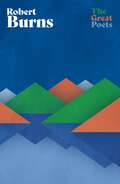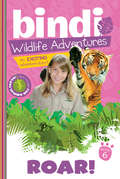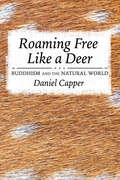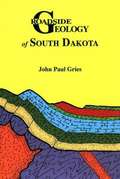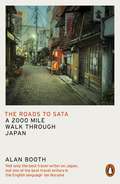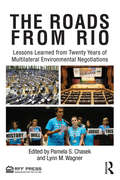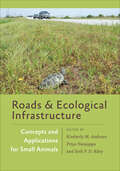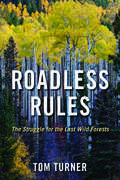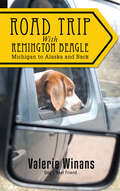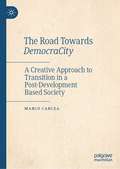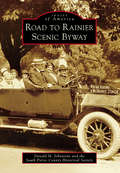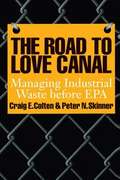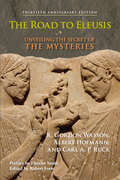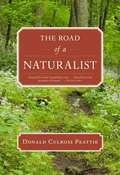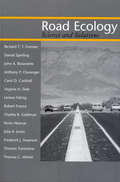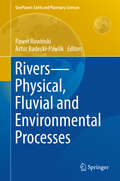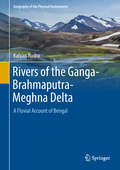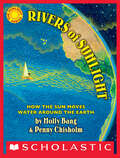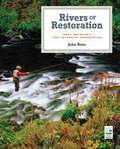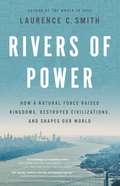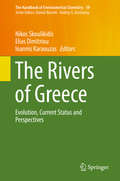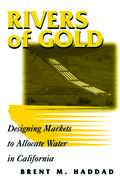- Table View
- List View
Robert Burns: A superb collection from Scotland’s finest lyrical poet (The Great Poets)
by Robert Burns'Oh would some power the gift give us, to see ourselves as others see us!' Robert BurnsRobert Burns, poet and lyricist, also known as Rabbie Burns, is widely regarded as the National Poet of Scotland - and much of his work has become part of everyday modern language:'The best laid schemes o' mice and men...''To see her is to love her...'Often credited with writing the lyrics for Auld Lang Syne, he almost single-handedly inspired the movement that preserved Scottish music and lyrics which had been handed down the generations vocally for centuries, thereby maintaining Scots culture and language.A cultural icon and pioneer of the Romantic movement, Burns was chosen as the greatest Scot in a 2009 poll. This collection includes some of his best-loved, most beautiful work.'Now's the day, now's the hour' Robert Burns
Robert Burns: A superb collection from Scotland’s finest lyrical poet (The Great Poets)
by Robert Burns'Oh would some power the gift give us, to see ourselves as others see us!' Robert BurnsRobert Burns, poet and lyricist, also known as Rabbie Burns, is widely regarded as the National Poet of Scotland - and much of his work has become part of everyday modern language:'The best laid schemes o' mice and men...''To see her is to love her...'Often credited with writing the lyrics for Auld Lang Syne, he almost single-handedly inspired the movement that preserved Scottish music and lyrics which had been handed down the generations vocally for centuries, thereby maintaining Scots culture and language.A cultural icon and pioneer of the Romantic movement, Burns was chosen as the greatest Scot in a 2009 poll. This collection includes some of his best-loved, most beautiful work.'Now's the day, now's the hour' Robert Burns
Roar!
by Bindi IrwinBindi, Robert and Terri Irwin are on their way to Sumatra to collect three gorgeous tiger cubs to take back with them to Australia Zoo. Soon after they are introduced to the mischievous trio, Bindi and her new friend Madi get involved in tracking down a nefarious gang of tiger poachers.
Roaming Free Like a Deer: Buddhism and the Natural World
by Daniel CapperBy exploring lived ecological experiences across seven Buddhist worlds from ancient India to the contemporary West, Roaming Free Like a Deer provides a comprehensive, critical, and innovative examination of the theories, practices, and real-world results of Buddhist environmental ethics. Daniel Capper clarifies crucial contours of Buddhist vegetarianism or meat eating, nature mysticism, and cultural speculations about spirituality in nonhuman animals. Buddhist environmental ethics often are touted as useful weapons in the fight against climate change. However, two formidable but often overlooked problems with this perspective exist. First, much of the literature on Buddhist environmental ethics uncritically embraces Buddhist ideals without examining the real-world impacts of those ideals, thereby sometimes ignoring difficulties in terms of practical applications. Moreover, for some understandable but still troublesome reasons, Buddhists from different schools follow their own environmental ideals without conversing with other Buddhists, thereby minimizing the abilities of Buddhists to act in concert on issues such as climate change that demand coordinated large-scale human responses. With its accessible style and personhood ethics orientation, Roaming Free Like a Deer should appeal to anyone who is concerned with how human beings interact with the nonhuman environment.
Roadside Geology of South Dakota
by John P. Gries James GriesemerA layperson's geological road map describing rocks and landforms along South Dakota's highways, as well as the geology lying beneath in caves and mine shafts. Gries (geology, South Dakota School of Mines) keeps it simple but informative, traveling from the glaciated prairies, across the Missouri River, and into the rugged Badlands Wall, the Needles, and the Homestake gold mine in the the West. Stops along the way include geologic tours of the Black Hills, Mount Rushmore, Wind Cave National Park, and Jewel Cave National Monument. Includes maps and photographs. Annotation c. by Book News, Inc., Portland, Or.
The Roads to Sata: A 2000-mile walk through Japan
by Alan Booth'A memorable, oddly beautiful book' Wall Street Journal'A marvellous glimpse of the Japan that rarely peeks through the country's public image' Washington PostOne sunny spring morning in the 1970s, an unlikely Englishman set out on a pilgrimage that would take him across the entire length of Japan. Travelling only along small back roads, Alan Booth travelled on foot from Soya, the country's northernmost tip, to Sata in the extreme south, traversing three islands and some 2,000 miles of rural Japan. His mission: 'to come to grips with the business of living here,' after having spent most of his adult life in Tokyo.The Roads to Sata is a wry, witty, inimitable account of that prodigious trek, vividly revealing the reality of life in off-the-tourist-track Japan. Journeying alongside Booth, we encounter the wide variety of people who inhabit the Japanese countryside - from fishermen and soldiers, to bar hostesses and school teachers, to hermits, drunks and the homeless. We glimpse vast stretches of coastline and rambling townscapes, mountains and motorways; watch baseball games and sunrises; sample trout and Kilamanjaro beer, hear folklore, poems and smutty jokes. Throughout, we enjoy the wit and insight of a uniquely perceptive guide, and more importantly, discover a new face of an often-misunderstood nation.
The Roads from Rio: Lessons Learned from Twenty Years of Multilateral Environmental Negotiations
by Pamela S. Chasek Lynn M. WagnerAt the 1992 United Nations Conference on Environment and Development, popularly known as the Rio Earth Summit, the world’s leaders constructed a new "sustainable development" paradigm that promised to enhance environmentally sound economic and social development. Twenty years later, the proliferation of multilateral environmental agreements points to an unprecedented achievement, but is worth examining for its accomplishments and shortcomings. This book provides a review of twenty years of multilateral environmental negotiations (1992-2012). The authors have participated in most of these negotiating processes and use their first-hand knowledge as writers for the International Institute for Sustainable Development’s Earth Negotiations Bulletin as they illustrate the changes that have taken place over the past twenty years. The chapters examine the proliferation of meetings, the changes in the actors and their roles (governments, nongovernmental organizations, secretariats), the interlinkages of issues, the impact of scientific advice, and the challenges of implementation across negotiating processes, including the Framework Convention on Climate Change, the Convention to Combat Desertification, the Convention on Biological Diversity, the Commission on Sustainable Development, the UN Forum on Forests, the chemicals conventions (Stockholm, Basel and Rotterdam), the Montreal Protocol on Substances that Deplete the Ozone Layer, the Convention on International Trade in Endangered Species, the Convention on Migratory Species and the International Treaty on Plant Genetic Resources for Food and Agriculture.
Roads and Ecological Infrastructure: Concepts and Applications for Small Animals (Wildlife Management and Conservation)
by Kimberly M. Andrews, Priya Nanjappa and Seth P. D. RileyA practical guide that explains how we can design roads that are compatible with populations of small wildlife.Few of us think twice about driving on roads. Yet the very presence of roads and the act of driving on them can impact the ecological infrastructure that supports an animal's daily life. What chance does a turtle have of successfully laying its eggs when it needs to traverse a busy highway? Is it realistic to expect small mammals to breed when an interstate thoroughfare subdivides their population? These are the sorts of challenges faced by small, often slow-moving, animals, challenges that road engineers and ecologists are trying to address.For countless small species, vehicles traveling at high speeds are nothing less than missiles shooting across migration pathways. For too many animals, the danger can lead to the loss of populations, in part because they simply are not programmed to react to traffic. Salamanders faced with a two-lane road between the forest and their aquatic breeding site, for example, will typically cross that road regardless of the congestion. The result can be hundreds of flattened animals in a single night.Roads and Ecological Infrastructure is the first book to focus on reducing conflict between roads and small animals. Highlighting habitat connections and the challenges and solutions from both transportation and ecological perspectives, the volume covers various themes, including animal behavior related to roads and design approaches to mitigate the negative effects of roads on wildlife. The chapter authors—from transportation experts to university researchers—each promote a goal of realistic problem solving. Conceptual and practical, this book will influence the next decade or more of road design in ecologically sensitive areas and should prevent countless unnecessary wildlife fatalities.Published in association with The Wildlife Society.
Roadless Rules: The Struggle for the Last Wild Forests
by Tom TurnerRoadless Rules is a fast-paced and insightful look at one of the most important, wide-ranging, and controversial efforts to protect public forests ever undertaken in the United States. In January 2000, President Clinton submitted to the Federal Register the Roadless Area Conservation Rule, prohibiting road construction and timberharvesting in designated roadless areas. Set to take effect sixty days after Clinton left office, the rule was immediately challenged by nine lawsuits from states, counties, off-road-vehicle users, and timber companies. The Bush administration refused to defend the rule and eventually sought to replace it with a rule that invited governors to suggest management policies for forests in their states. That rule was attacked by four states and twenty environmental groups and declared illegal. Roadless Rules offers a fascinating overview of the creation of the Clinton roadless rule and the Bush administration's subsequent replacement rule, the controversy generated, the response of the environmental community, and the legal battles that continue to rage more than seven years later. It explores the value of roadless areas and why the Clinton rule was so important to environmentalists, describes the stakeholder groups involved, and takes readers into courtrooms across the country to hear critical arguments. Author Tom Turner considers the lessons learned from the controversy, arguing that the episode represents an excellent example of how the system can work when all elements of the environmental movement work together--local groups and individuals determined to save favorite places, national organizations that represent local interests but also concern themselves with national policies, members of the executive branch who try to serve the public interest but need support from outside, and national organizations that use the legal system to support progress achieved through legislation or executive action.
Road Trip with Remington Beagle: Michigan to Alaska and Back
by Valerie WinansTake a road trip with me, Remington Beagle, from Traverse City, Michigan to various destinations in Alaska. As the head beagle in charge of this adventure, I will guide the reader along the famous Alaska Highway (also known as the Alcan). This recreational vehicle journey continues on some of the most scenic and exciting roads on the continent making this a unique travel log for people who love camping and storytelling beagles. This Alaska joyride takes us as far north as Barrow, Alaska (the most northern community on the North American Continent) to Homer, Alaska in the south and destinations in between. As you ramble with us along these roads and share the Alaska experience from a dog's eye view, you will be enticed to make this trek on your own. I will be happy to join you as I never tire of neither the Alaska experience nor the roads that take me there.
The Road Towards DemocraCity: A Creative Approach to Transition in a Post-Development Based Society
by Marco CarceaThis book discusses the challenges faced by the homo resaliens and his need for a transition to a more sustainable social, economic, and environmental system. It fills a gap in the existing literature and provides a new perspective by changing the etymology of the word resilience: no more resiliere, but resalio. By comparing and analysing the relevant literature, the author has coined the term homo resaliens (resilient man), in contrast to the failure of the homo oeconomicus, the corruption of the homo politicus, the incompleteness of homo sustinens, and the limits of homo ecologicus. Opening a new debate in which the role of academia and res publica are fundamental to safeguard human communities and future generations, this book will greatly assist governments that wish to understand the socio-political and economic implication of resilience in terms of social inclusiveness and long term social and environmental sustainability.
Road to Rainier Scenic Byway (Images of America)
by Donald M. Johnstone the South Pierce County Historical SocietyThe Road to Rainier Scenic Byway has grown from a Native American forest trail, hundreds of years old, to a modern forest highway carrying 1.5 million travelers a year. In 1833, a European tourist first reached a glacier, and soon others followed, seeking the wonders of Mount Rainier. In 1903, the railroad reached Eatonville; and national park visitors, who started as a few thousand, became tens of thousands. With a market for timber, hundreds rushed to claim the lands. Forestry and tourism both thrived off the rich natural resources, and as the region developed, purely commercial ventures were supplemented with educational outreach. Charles L. Pack Experimental Forest, established in 1926, conducts scientific research into forest management and sustainability. Historical interpretation has become a function of the Mount Rainier Scenic Railroad and Logging Museum. The Road to Rainier Scenic Byway continues to serve all as it heads to scenic Mount Rainier.
The Road to Love Canal
by Craig E. Colten Bruce Piasecki Peter N. SkinnerThe toxic legacy of Love Canal vividly brought the crisis in industrial waste disposal to public awareness across the United States and led to the passage of the Superfund legislation in 1980. To discover why disasters like Love Canal have occurred and whether they could have been averted with knowledge available to waste managers of the time, this book examines industrial waste disposal before the formation of the Environmental Protection Agency in 1970. Colten and Skinner build their study around three key questions. First, what was known before 1970 about the hazards of certain industrial wastes and their potential for causing public health problems? Second, what were the technical capabilities for treating or containing wastes during that time? And third, what factors other than technical knowledge guided the actions of waste managers before the enactment of explicit federal laws? The authors find that significant information about the hazards of industrial wastes existed before 1970. Their explanations of why this knowledge did not prevent the toxic legacy now facing us will be essential reading for environmental historians and lawyers, public health personnel, and concerned citizens.
The Road to Eleusis: Unveiling the Secret of the Mysteries
by R. Gordon Wasson Albert Hofmann Carl A. Ruck"...one of the two best kept secrets in history, and this book is the most successful attempt I know to unlock it. ... [A] historical tour de force."--Huston Smith, author of The World&’s ReligionsThe secretive Mysteries conducted at Eleusis in Greece for nearly two millennia have long puzzled scholars with strange accounts of initiates experiencing otherworldly journeys. In this groundbreaking work, three experts—a mycologist, a chemist, and a historian—argue persuasively that the sacred potion given to participants in the course of the ritual contained a psychoactive entheogen. The authors then expand the discussion to show that natural psychedelic agents have been used in spiritual rituals across history and cultures. Although controversial when first published in 1978, the book&’s hypothesis has become more widely accepted in recent years, as knowledge of ethnobotany has deepened. The authors have played critical roles in the modern rediscovery of entheogens, and The Road to Eleusis presents an authoritative exposition of their views. The book&’s themes of the universality of experiential religion, the suppression of that knowledge by exploitative forces, and the use of psychedelics to reconcile the human and natural worlds make it a fascinating and timely read. This 30th anniversary edition includes an appreciative preface by religious scholar Huston Smith and an updated exploration of the chemical evidence by Peter Webster.
The Road of a Naturalist
by Donald Culross PeattieThe Road of a Naturalist is a fascinating autobiographical wonder written by one of America's most beloved naturalists at the height of his fame. A scientist, a philosopher, and a poet, Donald Culross Peattie takes us on an confessional journey across the landscape of his life. Told in flashbacks of years past and interspersed with impressions of a journey by motorcar across the American West, it is intensely personal. It is American in the best sense of the word. From saying goodbye to the trees at his childhood home on Lake Michigan to a man formed via Harvard and New York City, finally discovering a belief in the nature of things in a cabin in the Grand Tentons, it is not told as as linear life story but rather an adventure in living, in science, in thought.
The Road of a Naturalist
by Donald Culross PeattieThe Road of a Naturalist is a fascinating autobiographical wonder written by one of America's most beloved naturalists at the height of his fame. A scientist, a philosopher, and a poet, Donald Culross Peattie takes us on an confessional journey across the landscape of his life. Told in flashbacks of years past and interspersed with impressions of a journey by motorcar across the American West, it is intensely personal. It is American in the best sense of the word. From saying goodbye to the trees at his childhood home on Lake Michigan to a man formed via Harvard and New York City, finally discovering a belief in the nature of things in a cabin in the Grand Tentons, it is not told as as linear life story but rather an adventure in living, in science, in thought.
Road Ecology: Science and Solutions
by Virginia H. Dale Daniel Sperling Anthony P. Clevenger Richard T.T. Forman Carol D. Cutshall John A. BissonetteA central goal of transportation is the delivery of safe and efficient services with minimal environmental impact. In practice, though, human mobility has flourished while nature has suffered. Awareness of the environmental impacts of roads is increasing, yet information remains scarce for those interested in studying, understanding, or minimizing the ecological effects of roads and vehicles. Road Ecology addresses that shortcoming by elevating previously localized and fragmented knowledge into a broad and inclusive framework for understanding and developing solutions. The book brings together fourteen leading ecologists and transportation experts to articulate state-of-the-science road ecology principles, and presents specific examples that demonstrate the application of those principles. Diverse theories, concepts, and models in the new field of road ecology are integrated to establish a coherent framework for transportation policy, planning, and projects. Topics examined include: *foundations of road ecology *roads, vehicles, and transportation planning *vegetation and roadsides *wildlife populations and mitigation *water, sediment, and chemical flows *aquatic ecosystems *wind, noise, and atmospheric effects *road networks and landscape fragmentationRoad Ecology links ecological theories and concepts with transportation planning, engineering, and travel behavior. With more than 100 illustrations and examples from around the world, it is an indispensable and pioneering work for anyone involved with transportation, including practitioners and planners in state and province transportation departments, federal agencies, and nongovernmental organizations. The book also opens up an important new research frontier for ecologists.
Rivers - Physical, Fluvial and Environmental Processes
by Paweł Rowiński Artur Radecki-PawlikThis book describes the domain of research and investigation of physical, chemical and biological attributes of flowing water, and it deals with a cross-disciplinary field of study combining physical, geophysical, hydraulic, technological, environmental interests. It aims to equip engineers, geophysicists, managers working in water-related arenas as well as advanced students and researchers with the most up to date information available on the state of knowledge about rivers, particularly their physical, fluvial and environmental processes. Information from various but also interrelated areas available in one volume is the main benefit for potential readers. All chapters are prepared by leading experts from the leading research laboratories from all over the world.
Rivers of the Ganga-Brahmaputra-Meghna Delta: A Fluvial Account Of Bengal (Geography of the Physical Environment)
by Kalyan RudraThis is the first comprehensive book on the rivers of the Ganga-Brahmaputra-Meghna delta. This volume covers all aspects of this highly populated region including land conflicts and environmental impacts such as the Indo-Bangladesh conflict over sharing of trans-boundary water. This book addresses the topic from a highly interdisciplinary perspective covering areas of geography, geology, environment, history, archaeology, sociology and politics of the Bengal region.The book appeals to a wide range of audiences from India, Bangladesh and the international community. The style of presentation makes it easily suitable for students, researchers and interested laymen.
Rivers of Sunlight: How the Sun Moves Water Around the Earth
by Molly Bang Penny ChisholmThree-time Caldecott Honor Artist Molly Bang and National Science Award-winning professor Penny Chisholm present a stunning, accessible explanation of the Earth's water cycle and its global effects.With stunning artwork and compelling scientific explanation, Bang and Chisholm have brought forth a masterpiece that is critically relevant in this environmentally tumultuous time. How does the sun keep ocean currents moving and lift fresh water from the seas? What can we do to conserve one of our planet's most precious resources? In this newest book in the award-winning Sunlight Series, readers learn about the constant movement of water as it flows around the Earth. As the water changes between liquid, vapor, and ice, Sunlight powers all living things, ensuring that life can exist on Earth.Perfect for any reader--young or old!--this is an invaluable addition to all classrooms, libraries, and at-home collections.
Rivers of Restoration: Trout Unlimited's First 50 Years of Conservation
by John RossA beautiful tribute to twenty rivers restored by the work of Trout Unlimited and its members. We all love rivers and the trout that the best of them hold. For fifty years, the volunteers of Trout Unlimited have strived to restore, sustain, and preserve the nation's trout and salmon waters. Weaving together human and natural histories, Ross tells the stories of twenty watersheds where Trout Unlimited has labored to save rivers damaged by human shortsightedness. From Michigan's Au Sable to New York's Delaware to rivers in California, Washington, and more, the stories of these rivers-both in peril and in recovery-will remind fishermen why they love the sound of running water, and why our natural resources need to be protected. 200 color photographs.
Rivers of Power: How a Natural Force Raised Kingdoms, Destroyed Civilizations, and Shapes Our World
by Laurence C. SmithAn "eye-opening, sometimes alarming, and ultimately inspiring" natural history of rivers and their complex and ancient relationship with human civilization (Elizabeth Kolbert, Pulitzer Prize-winning author of The Sixth Extinction).Rivers, more than any road, technology, or political leader, have shaped the course of human civilization. They have opened frontiers, founded cities, settled borders, and fed billions. They promote life, forge peace, grant power, and can capriciously destroy everything in their path. Even today, rivers remain a powerful global force -- one that is more critical than ever to our future.In Rivers of Power, geographer Laurence C. Smith explores the timeless yet underappreciated relationship between rivers and civilization as we know it. Rivers are of course important in many practical ways (water supply, transportation, sanitation, etc). But the full breadth of their influence on the way we live is less obvious. Rivers define and transcend international borders, forcing cooperation between nations. Huge volumes of river water are used to produce energy, raw commodities, and food. Wars, politics, and demography are transformed by their devastating floods. The territorial claims of nations, their cultural and economic ties to each other, and the migrations and histories of their peoples trace back to rivers, river valleys, and the topographic divides they carve upon the world. And as climate change, technology, and cities transform our relationship with nature, new opportunities are arising to protect the waters that sustain us.Beautifully told and expansive in scope, Rivers of Power reveals how and why rivers have so profoundly influenced our civilization and examines the importance this vast, arterial power holds for the future of humanity."As fascinating as it is beautifully written."---Jared Diamond, Pulitzer Prize-winning author of Guns, Germs, and Steel, Collapse, and Upheaval
The Rivers of Greece
by Nikos Skoulikidis Elias Dimitriou Ioannis KaraouzasThis volume provides essential information on the origin and evolution of Greek rivers, as well as their ecological and anthropogenic characteristics. The topics covered include geomythology, biogeography, hydrology, hydrobiology, hydrogeochemistry, geological and biogeochemical processes, anthropogenic pressures and ecological impacts, water management - both in the antiquity and today - and river restoration. The book is divided into four parts, the first of which explores the importance of rivers for ancient Greek civilization and the natural processes affecting their evolution during the Holocene. In the second part, the hydrological, hydrochemical and biological features of Greek rivers and the unique biogeographical characteristics that form the basis for their high biodiversity and endemism are highlighted, while the third part comprehensively discusses the impacts of environmental pollution on the structure and function of Greek river ecosystems. In turn, the final part describes the current socio-economic factors in Greece that are affecting established water management practices, the application of ecohydrological approaches in restoring fragmented rivers, and the lessons learned from restoring aquatic ecosystems in general as a paradigm for understanding and minimizing anthropogenic impacts on water resources, at the Mediterranean scale. Given the breadth and depth of its coverage, the book offers an invaluable source of information for researchers, students and environmental managers alike.
Rivers of Gold: Designing Markets To Allocate Water In California
by Brent M. HaddadThe movement to implement market-based approaches to allocating water is gaining ground across California and in other western states. Proponents argue that markets offer an efficient and cost-effective means of promoting conservation -- those who need water would pay for it on the open market, while others would conserve rather than pay increased prices.Rivers of Gold takes a new look at California's water-reallocation challenge. The author explains the concept of water markets and the economic theory undergirding them. He shows how some water markets have worked -- and others have failed -- and gives the reader the analytic tools necessary to understand why. The book: provides an overview of water-supply issues in California compares the situation in California with that of other western states considers the different property rights regimes governing current use and their fit with water market institutions explains how water markets would work and their benefits and drawbacks as an allocation mechanism presents a series of case studies of water markets currently in effect in California offers a list of principles for water market designRivers of Gold offers a balanced understanding of both the role that markets can play in reallocating water and the limitations of the market mechanism. In the end, the author offers a comprehensive assessment of the institutional design features that any water market should incorporate if it is to reallocate water effectively, in California or in any other region where water is scarce.Rivers of Gold is the first book to provide a detailed examination of water markets and the institutional design issues associated with them. It is the only book available that presents in-depth case studies of actual water-market transactions, and will be essential reading for water resource professionals and resource economists, as well as for students and scholars of environmental policy, environmental economics, and resource economics.
Rivers of Empire: Water, Aridity, and the Growth of the American West
by Donald WorsterWhen Henry David Thoreau went for his daily walk, he would consult his instincts on which direction to follow. More often than not his inner compass pointed west or southwest. "The future lies that way to me," he explained, "and the earth seems more unexhausted and richer on that side. " In his own imaginative way, Thoreau was imitating the countless young pioneers, prospectors, and entrepreneurs who were zealously following Horace Greeley's famous advice to "go west. " Yet while the epic chapter in American history opened by these adventurous men and women is filled with stories of frontier hardship, we rarely think of one of their greatest problems--the lack of water resources. And the same difficulty that made life so troublesome for early settlers remains one of the most pressing concerns in the western states of the late-twentieth century. The American West, blessed with an abundance of earth and sky but cursed with a scarcity of life's most fundamental need, has long dreamed of harnessing all its rivers to produce unlimited wealth and power. In Rivers of Empire, award-winning historian Donald Worster tells the story of this dream and its outcome. He shows how, beginning in the mid-nineteenth century, Mormons were the first attempting to make that dream a reality, damming and diverting rivers to irrigate their land. He follows this intriguing history through the 1930s, when the federal government built hundreds of dams on every major western river, thereby laying the foundation for the cities and farms, money and power of today's West. Yet while these cities have become paradigms of modern American urban centers, and the farms successful high-tech enterprises, Worster reminds us that the costs have been extremely high. Along with the wealth has come massive ecological damage, a redistribution of power to bureaucratic and economic elites, and a class conflict still on the upswing. As a result, the future of this "hydraulic West" is increasingly uncertain, as water continues to be a scarce resource, inadequate to the demand, and declining in quality. Rivers of Empire represents a radically new vision of the American West and its historical significance. Showing how ecological change is inextricably intertwined with social evolution, and reevaluating the old mythic and celebratory approach to the development of the West, Worster offers the most probing, critical analysis of the region to date. He shows how the vast region encompassing our western states, while founded essentially as colonies, have since become the true seat of the American "Empire. " How this imperial West rose out of desert, how it altered the course of nature there, and what it has meant for Thoreau's (and our own) mythic search for freedom and the American Dream, are the central themes of this eloquent and thought-provoking story--a story that begins and ends with water.
